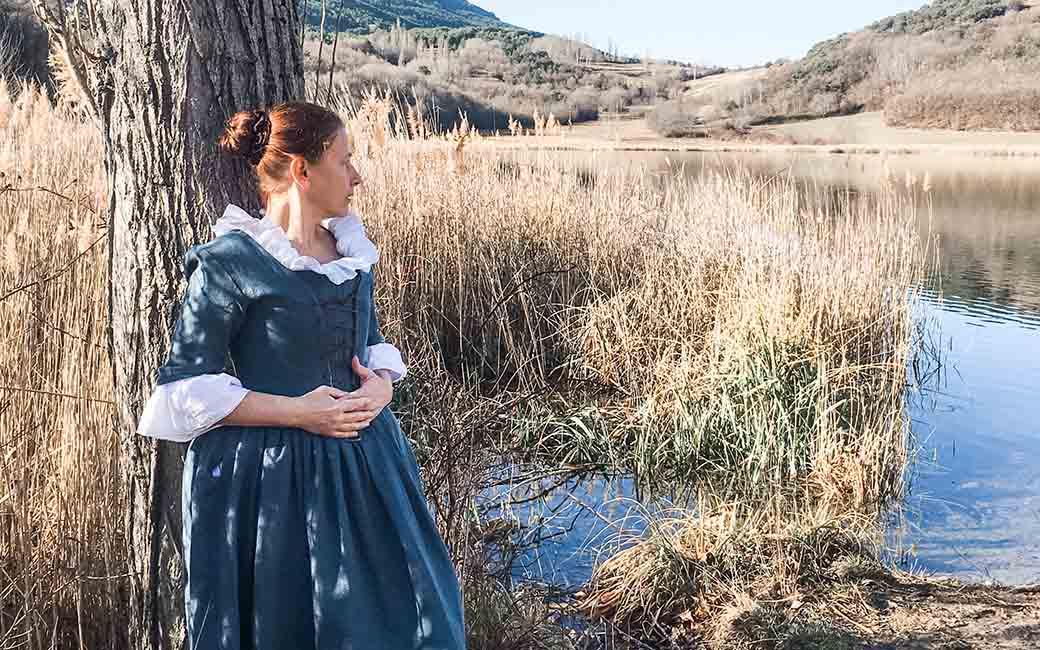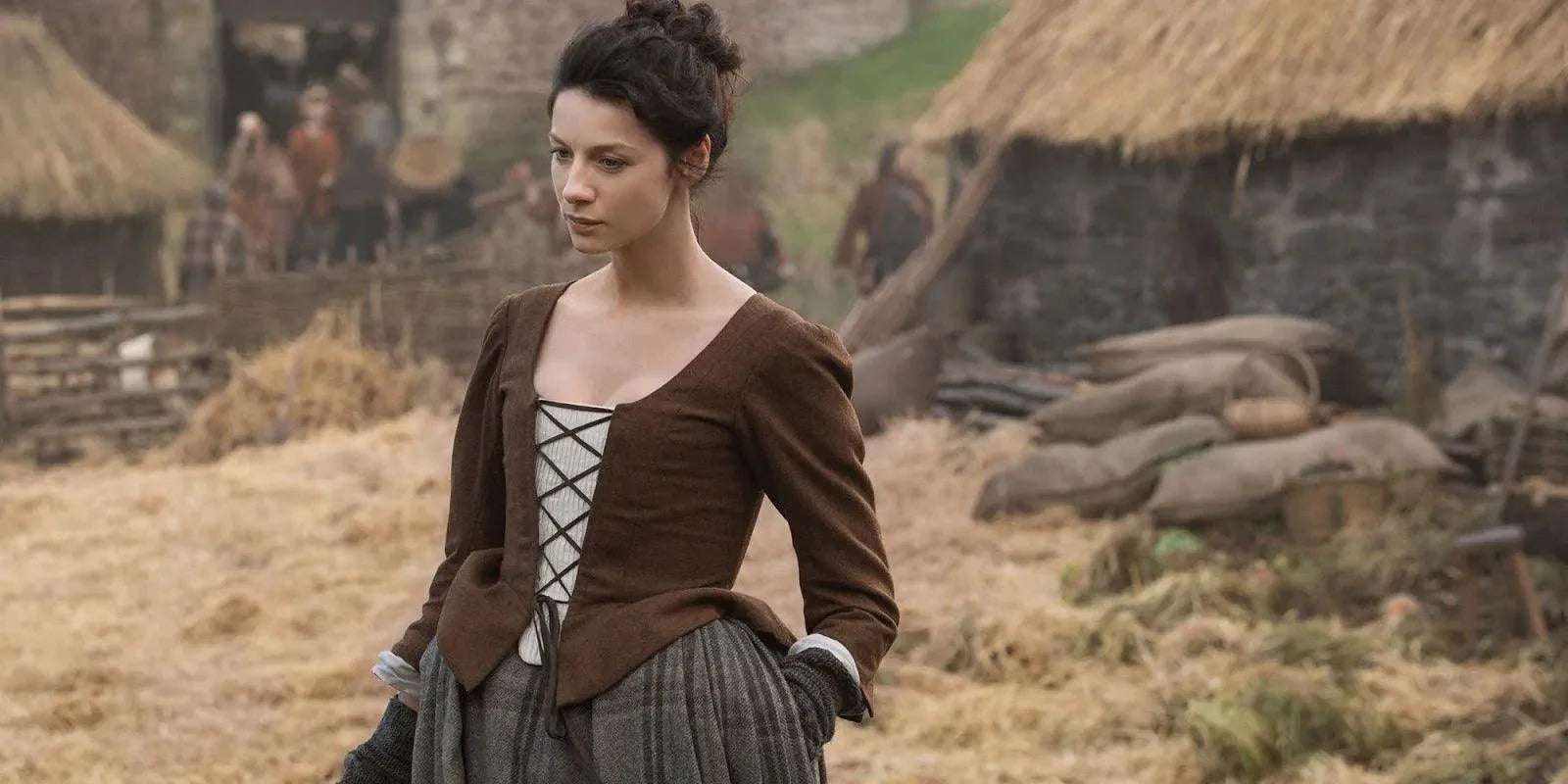Nestled in the heart of the Pyrenees mountains lies the peaceful valley of La Vall Fosca. With its charming villages and breathtaking natural scenery, this hidden gem offers a captivating backdrop for my stroll today. As I take in the beauty surrounding me, I'm reminded of the rich cultural history embedded in these ancient landscapes.
My goal on this crisp winter day is to explore the world of historic fashion, using one of my own ensembles as a window into the past. By examining the practical yet-feminine garments I'm wearing, we'll gain insight into the lives and experiences of 18th-century peasant women. Join me as I reflect on the deeper meaning behind my outfit and vividly imagine myself transported back in time. Though the modern world feels far away, the timeless beauty of the mountains helps conjure up visions of the women who once walked these same wooded paths.

The Dorine Ensemble
I'm wearing the Dorine ensemble, consisting of a short lace-up jacket with stomacher and a historic skirt pleated in 18th-century style. The ensemble is made from pre-washed cherry-red linen. A color that contrasts with the dazzling white of the snow that has already fallen in early winter, and the trees that are beginning to take on shades of gray.
The lace-up jacket features a stomacher, which is a triangular piece that fills in the front of the bodice. Stomachers were commonly used in women's fashion in previous centuries to allow the same jacket to accommodate different sizes. The skirt is pleated and styled after historic 18th-century fashion. This type of pleating allows for comfortable movement while still maintaining a classic silhouette.
Both pieces of the Dorine ensemble are constructed from linen fabric in a vivid cherry-red hue. The linen has been pre-washed, giving it a softened hand and the ability to breathe comfortably. The bright cherry red is eye-catching, especially against the white snowy backdrop of the Pyrenees in winter. This pop of color enlivens the gray trees and wintry landscape.

Contrast With the Landscape
A short stroll through the snow-covered Pyrenean valley provides a striking backdrop for the vibrant red Dorine ensemble. The stark white of the freshly fallen snow against the bare gray trees creates a monochromatic wintery scene. Yet as I walk along the path in my cherry-red linen skirt and short lace-up jacket, I stand out brightly against the muted natural landscape.

The bold and colorful fabric contrasts vividly with the peaceful white and gray hues of the mountains, trees, and snow. The eye is immediately drawn to the pop of brightness from the traditional pleated skirt and tailored stomacher jacket. Red has always been a dramatic shade, associated with passion, excitement, and energy. Against the serene winter backdrop, the ensemble evokes a sense of life and vitality, like a single rose blooming amid the snow.
The saturated crimson plays off the muted grays nicely. As the only spot of color around, the outfit feels both eye-catching and harmonious strolling through the valley. The cool neutral tones allow the vibrant red fibers to truly sing. Overall, the look provides a beautiful juxtaposition of rich, vibrant color against the hushed winter landscape.

History of Peasant Fashion
This Dorine ensemble represents something of the spirit of 18th-century European peasantry with its practical and versatile design. The short lace-up jacket with stomacher and historic skirt pleated in 18th-century style would have been typical attire for peasant women of the era.
The loose, lightweight fabrics and uncomplicated construction made these garments easy to work and move around in. Peasant women needed clothing that was suitable for their physically demanding daily routines in the fields, barns, and markets. At the same time, the lace-up adjustability of the jacket and the wrapped and pleated styling of the skirt accommodated changes in body shape over the course of a woman's adulthood, from youth to motherhood to later years. This was important in an age when most peasant women could not afford to replace their entire wardrobe frequently. These pieces were designed to last and adapt.
While practical, the bright red color and feminine touches like the stomacher added a touch of vibrancy and style to this humble ensemble. The lace-up jacket flatters the figure while allowing for adjustable fit, and the full skirt provides freedom of movement for working. The outfit represents both the simplicity and sensibility of peasant fashion in 18th century Europe.

Limited Wardrobes
Peasant women in the 18th century had extremely limited wardrobes. Very few could afford the luxury of purchasing new clothes for themselves. Instead, most had to make do with garments handed down from their mothers, sisters, and grandmothers. Outfits were recycled and repurposed within families for generations.
Jackets, skirts, and other pieces were designed to be durable and adaptable. As clothing was passed down, styles and sizes were adjusted as needed. This practicality was an essential part of a peasant woman's wardrobe. While limited, these well-worn hand-me downs allowed women to stay covered and clothed as they worked. The limitations also encouraged creativity and resourcefulness when it came to repairing and restyling clothes.
Though small, a peasant woman's wardrobe played an important role. It kept her protected as she carried out her daily tasks. Simple yet functional clothing connected her to past generations of women in her family. Her outfit intertwined femininity with the practicality needed to work and survive. Within its limitations, her humble wardrobe allowed her to embrace womanhood while taking pride in being a hard-working peasant.

Femininity in Peasant Fashion
Though practical and functional, the Dorine ensemble maintains a sense of femininity. The tailored lace-up jacket flatters the figure with its stomacher front, while the full pleated skirt creates a romantic silhouette. Despite being designed for work, the outfit projects grace and beauty.
The bright cherry red linen adds a lively flair, distinguishing this ensemble from the more muted, earthy tones typical of peasant dress. The vibrant color injects a playful, cheerful energy. Red has symbolized passion and vibrancy across cultures and eras, from ancient goddesses to modern fashion. This shade in particular evokes youthful joy.
Both the cut and the color work together to keep the outfit feeling feminine. There is a delicate balance between practicality and beauty. Form follows function, yet an eye for aesthetics remains. The end result is charming apparel bringing loveliness to even the humblest of lifestyles.

Evoking Fairy Tales
As I walk alone through the quiet woods wearing my bright red Dorine ensemble, I can't help but be reminded of the fairy tale Little Red Riding Hood. The vibrant cherry color of my skirt and jacket seems especially fitting for my solitary stroll through the trees. I find myself glancing warily around as if half expecting a wolf to appear at any moment! Of course there are no wolves here, but the vivid storybook imagery springs readily to mind.
This far-flung corner of the Pyrenees has a timeless, storybook quality to it. The fixture of Little Red Riding Hood in the popular imagination demonstrates the power clothing color can have in evoking tales both cautionary and fantastical. In my bright red outfit, I become a part of the scenery around me, a bright splash of color in the midst of the muted winter tones of the forest. Just as Little Red Riding Hood's unmistakable cloak forever ties her to the woods and wolves in our collective memory, the red of my Dorine ensemble weaves me into the natural landscape in a vivid, imaginative way. Though no wolves appear today, the spirit of folk tales past colors my journey.

Unique Perspective
Experiencing history through the lens of clothing provides a distinctive viewpoint unlike any other. Donning historic garments allows us to transcend time, connecting viscerally with the lives of those who came before us.
The physicality of historical attire conveys a wealth of insight and understanding that goes far deeper than words alone ever could. Feeling the weight and texture of fabrics, the construction and fit of a bodice, the swish of skirts, grounds history in a full-sensory experience. Costumed interpretation breathes new life into the past.
Immersing oneself in the fashions of bygone eras also reveals the practical realities of daily life. The limited wardrobes of peasant women, stitched together from inherited hand-me-downs, tell of thrift and making-do from one generation to the next. Impressions of social customs, gender roles, and human ingenuity all emerge from the subtleties of dress.
By donning the garb of prior ages, we gain an empathetic bridge to those who wore them originally. The Dorine ensemble channels an 18th-century peasant woman as vividly as though she stood before us today. Her reality becomes ours, if only fleetingly. We are offered a chance to walk in her shoes, see through her eyes, and connect with universal human experiences that transcend the boundaries of time itself.
Conclusion
Taking a leisurely stroll through the Pyrenean valley provided a glimpse into the history and practicality of 18th-century peasant fashion. The cherry red linen Dorine ensemble stood out brightly against the snowy landscape, evoking imaginings of fairy tale characters.
The lace-up jacket with stomacher and pleated skirt represented the practicality and femininity of clothing worn by peasant women who often inherited well-worn garments. While limited in variety, these durable and adaptable outfits suited the physical demands of farm work while allowing freedom of movement.
Beyond the wardrobe itself, the stroll inspired contemplation about the daily lives and challenges faced by peasant women throughout history. Their world was vastly different from the one we know today, yet their need for functional, affordable attire connects us across the centuries. Although brief, this walk provided a portal to the past through the lens of historical fashion.



